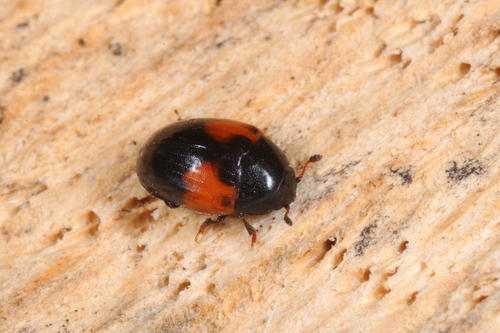Tritoma bipustulata Fabricius, 1775 (Coleoptera: Erotylidae) in Wyre Forest. Status: National Scarce A
John Bingham
On 2nd September 2011 at Pound Green Common, Worcestershire (VC Staffordshire) I discovered a small ladybird-like beetle with red elytra marking in a decayed birch stump c.30cm diameter (Fig. 1.). The beetle was within the rot layer beneath several decayed Trametes spp. fruitbodies. Several beetle larvae were also noted in the decayed wood and frass layer, probably Pyrochroa species. The ladybird-like specimen was collected and later determined as Tritoma bipustulata, an uncommon fungus beetle. A search on the internet provided further information and it became clear it was a somewhat unusual find.
Rather amazingly Alan Brown had also found four of the same beetles earlier in the year at the Devil' Spittleful on 18th April 2011, also in a decaying birch. This being the only other Worcestershire record. (John Meiklejohn pers. comm). Of interest it had apparently not been recorded by Paul Whitehead in his extensive list for Bredon Hill (Keith Alexander pers. comm. 2011)
The IUNC Red List of Threatened Species webpage quotes:
'Listed as Least Concern in Europe. An obligate saproxylic species. The Population trend is stable. In the UK it has the conservation status, Nationally Scarce (Hyman and Parsons 1992). In the UK it has a very fragmented distribution, with about 30 small isolated populations known, plus one or maybe two larger concentrations (K.N.A. Alexander pers. comm. 2009). The larvae develop in fruiting bodies of wood-decay fungi, and it is best known in the UK from Trametes versicolor, especially on beech Fagus; ancient wood pastures and woodlands, old fen, and historic parklands (Alexander 2002).'
The Pound Green Common site was on the boundary with the restored heathland common. The birch tree was cut down c5 years ago as part of the restoration works. It is located within mature secondary woodland that merges into ancient wood pasture with the associated ancient woodland ground flora. The site is contiguous with the rest of the Wyre Forest. Despite the coppice history of Wyre a strong saproxylic fauna is still present within the forest and I believe that with more recording Wyre will prove to be an important site in the Midlands for saproxylic species.
Thanks to Harry Green for supplying information on the records.
References
Hymans, P. S. & Parsons, M. S. 1992. A review of the scarce and threatened Coleoptera of Great Britain 1. JNCC
Alexander, K. N. A. 2002. The invertebrates of living and decaying timber in Britain & Ireland . A provisional annotated checklist. English Nature Research Reports No 467. Natural England, Peterborough.
Image
Fig. 1. Tritoma bipustulata at Pound Green. ©John.Bingham
